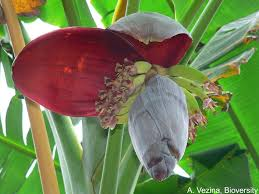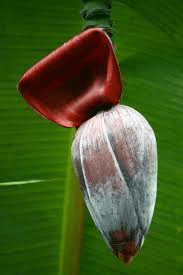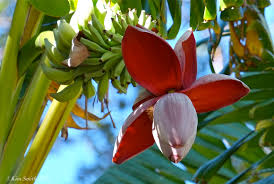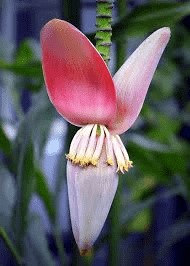Banana inflorescence, often referred to as the banana heart or banana blossom, is a distinctive and versatile part of the banana plant. It is located at the end of the banana fruit cluster and consists of tightly packed layers of bracts and florets, each with its own unique characteristics and uses.
Structurally, the banana inflorescence is composed of several layers of bracts, which are large, reddish-purple, and overlap to protect the developing florets inside. These bracts gradually unfold as the inflorescence matures, revealing rows of cream-colored tubular flowers. The outermost layers contain female flowers that develop into bananas when pollinated, while the inner layers consist of smaller, male flowers that typically do not develop into fruit.
Culinary uses of banana inflorescence are widespread across various cuisines, particularly in Southeast Asia and South Asia. The tender inner petals and florets are edible and prized for their unique flavor and texture.
They are commonly used in salads, soups, curries, stir-fries, and pickles. In Filipino cuisine, banana inflorescence is known as “puso ng saging” and is used in dishes such as sinigang (sour soup) and adobo (braised meat dishes). In Thai cuisine, it is used in salads like “yum hua plee” and in curries such as “gang kiew wan” (green curry). The inflorescence is prepared by removing the outer bracts and the tough inner core, then slicing or shredding the edible parts for cooking.
Nutritionally, banana inflorescence is rich in dietary fiber, vitamins (such as A, C, and E), and minerals (including potassium, calcium, and iron). Its high fiber content supports digestive health and helps regulate blood sugar levels. The inflorescence also contains antioxidants, which can help reduce inflammation and oxidative stress in the body.
Medicinally, banana inflorescence has been used in traditional remedies for various health benefits. It is believed to have diuretic properties, aiding in detoxification and promoting kidney health. The inflorescence is also used to manage diabetes by regulating blood glucose levels. Additionally, it is used to treat menstrual disorders and promote lactation in breastfeeding mothers.
Culturally, banana inflorescence holds significance in religious ceremonies and cultural traditions in many tropical regions. It is often used in ceremonial offerings and rituals, symbolizing fertility, prosperity, and auspicious beginnings. Its vibrant color and unique shape make it a visually striking and symbolic element in festivals and celebrations.
In agriculture, banana inflorescence plays a critical role in the reproduction of the banana plant. As the inflorescence develops, the female flowers are pollinated and eventually develop into banana fruit clusters. The male flowers, which are often removed to focus the plant’s energy on fruit production, can be harvested and used for various purposes, adding value to the banana crop beyond fruiting.
Environmentally, the use of banana inflorescence supports sustainable farming practices by minimizing waste and maximizing the use of all parts of the banana plant. This holistic approach to agriculture helps conserve natural resources and reduce environmental impact.
Banana inflorescence is a versatile and valuable part of the banana plant, with culinary, medicinal, cultural, and agricultural significance. Its nutritional benefits, unique flavor profile, and cultural symbolism highlight its importance in various aspects of tropical and subtropical societies. As a sustainable resource, banana inflorescence exemplifies the integration of natural resources into diverse human practices, promoting health, cultural heritage, and environmental stewardship.
The Economic Importance and Uses of Banana Inflorescence

1. Culinary Delicacy: Banana inflorescence, also known as banana heart or banana blossom, is used as a vegetable in various cuisines. It is commonly used in salads, curries, and stir-fries.
2. Nutritional Value: Banana inflorescence is rich in fiber, vitamins (such as vitamin C and vitamin A), minerals (like potassium and calcium), and antioxidants. It provides a nutritious addition to diets.
3. Traditional Medicine: In traditional medicine practices, banana inflorescence is used to treat ailments such as respiratory issues and menstrual problems.
4. Anti-inflammatory Properties: Banana inflorescence contains compounds with anti-inflammatory properties, which can help reduce inflammation in the body.
5. Culinary Pickles: The tender parts of banana inflorescence can be pickled and preserved, adding flavor to various dishes.
6. Animal Feed: Banana inflorescence can be used as feed for livestock, providing a nutritious supplement.
7. Bioactive Compounds: Extracts from banana inflorescence are studied for their bioactive compounds, which have potential pharmaceutical applications.
8. Herbal Teas: Infusions made from banana inflorescence are consumed as herbal teas, believed to have health benefits such as improving digestion and boosting immunity.
9. Culinary Extracts: Extracts from banana inflorescence are used in culinary applications to impart flavor and nutrition to dishes.
10. Ornamental Plant: The large, striking appearance of banana inflorescence makes it suitable for decorative purposes in gardens and landscapes.
11. Soil Enrichment: Decomposed banana inflorescence can be used as organic fertilizer, enriching soil with nutrients.
12. Composting: Banana inflorescence is beneficial for composting, providing organic material that breaks down into nutrient-rich compost.
13. Natural Dye: Extracts from banana inflorescence are used to produce natural dyes for textiles, adding color without synthetic chemicals.
14. Beekeeping: The nectar from banana inflorescence attracts bees, supporting pollination activities and honey production.
15. Biodegradable Packaging: Fibrous materials from banana inflorescence can be processed into biodegradable packaging materials, reducing environmental impact.
16. Art and Crafts: Banana inflorescence parts are used in art and crafts for their unique texture and appearance.
17. Culinary Fusion: In modern cuisine, banana inflorescence is used in fusion dishes to create innovative flavors and textures.
18. Sustainable Agriculture: The cultivation and use of banana inflorescence promote sustainable agricultural practices due to its multiple uses and low environmental impact.
Read Also: 3 Health Benefits of Slippery Elm (Ulmus fulva)
The Products and By-products That Can Be Derived From Banana Inflorescence

1. Culinary Dishes: Banana inflorescence is used in a variety of culinary dishes such as salads, curries, and stir-fries. The process involves cleaning, peeling, and cooking the tender parts.
2. Nutritional Supplements: Extracts from banana inflorescence are used in nutritional supplements due to their high nutrient content. The process includes drying and powdering the inflorescence.
3. Traditional Medicine: Banana inflorescence is used in traditional medicine for respiratory issues and menstrual problems. The process involves preparing infusions or extracts.
4. Animal Feed: Chopped banana inflorescence is used as feed for livestock, providing essential nutrients. The process includes harvesting and processing the inflorescence.
5. Anti-inflammatory Products: Extracts from banana inflorescence are used in products to reduce inflammation. The process includes extracting active compounds and formulating them into products.
6. Bioactive Compounds: Banana inflorescence is processed to isolate bioactive compounds for pharmaceutical applications. This involves extraction and analysis of compounds.
7. Herbal Teas: Infusions made from banana inflorescence are consumed as herbal teas. The process involves drying and brewing the inflorescence.
8. Culinary Extracts: Extracts from banana inflorescence are used in culinary applications for flavoring and nutritional enhancement. The process includes extracting and purifying the compounds.
9. Soil Enrichment: Decomposed banana inflorescence is used as organic fertilizer. This involves composting the inflorescence and applying it to crops.
10. Composting: Banana inflorescence is beneficial for composting, providing organic material for gardening. The process includes chopping and mixing the inflorescence with other organic waste.
11. Natural Dye: Extracts from banana inflorescence are used to produce natural dyes for textiles. The process includes boiling the inflorescence and extracting the dye.
12. Beekeeping: The nectar from banana inflorescence attracts bees, supporting beekeeping and pollination activities. This involves cultivating banana plants and harvesting the inflorescence.
13. Biodegradable Packaging: Fibrous materials from banana inflorescence are processed into biodegradable packaging materials. This involves pulping and molding the fibers.
14. Art and Crafts: Parts of banana inflorescence are used in art and crafts for their unique texture and appearance. This involves drying and preserving the inflorescence.
15. Culinary Fusion: Banana inflorescence is used in modern cuisine for fusion dishes. This involves experimenting with different cooking methods and flavor combinations.
Read Also: 6 Health Benefits of Oregano (Origanum vulgare)
Frequently Asked Questions (FAQ’s) About Banana Inflorescence

1. What are banana inflorescence used for?
Banana inflorescence are used for culinary dishes, nutritional supplements, traditional medicine, animal feed, anti-inflammatory products, bioactive compounds, herbal teas, culinary extracts, soil enrichment, composting, natural dye, beekeeping, biodegradable packaging, art and crafts, culinary fusion, and sustainable agriculture.
2. How do you prepare banana inflorescence for cooking?
To prepare banana inflorescence for cooking, remove the tough outer bracts, slice the tender inner parts, and cook them in dishes like curries, stir-fries, or salads.
3. Are banana inflorescence edible?
Yes, banana inflorescence are edible and used in various culinary dishes, especially in Asian cuisines.
4. What are the health benefits of banana inflorescence?
Banana inflorescence are rich in fiber, vitamins, minerals, antioxidants, and bioactive compounds. They are used to treat respiratory issues, menstrual problems, and inflammation, and are beneficial for overall health.
5. Can banana inflorescence be used in herbal teas?
Yes, infusions made from banana inflorescence are consumed as herbal teas, believed to have health benefits such as improving digestion and boosting immunity.
6. How are banana inflorescence used in biodegradable packaging?
Fibrous materials from banana inflorescence are processed into biodegradable packaging materials. This involves pulping the fibers and molding them into packaging products.
7. Are there commercial products made from banana inflorescence?
Yes, products such as culinary dishes, nutritional supplements, traditional medicine remedies, animal feed, anti-inflammatory products, bioactive compounds, herbal teas, culinary extracts, soil enrichment products, compost, natural dyes, beekeeping supplies, biodegradable packaging materials, art and crafts items, and culinary fusion dishes are made from banana inflorescence.
Read Also: Practical Steps to Covert Paper Wastes into New Paper Products

